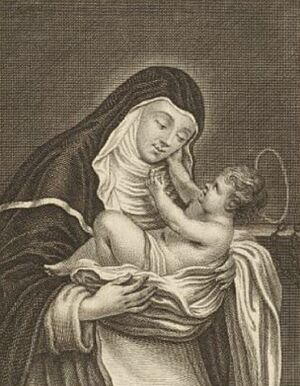Margareta Ebner facts for kids
Quick facts for kids BlessedMargareta Ebner O.P. |
|
|---|---|
 |
|
| Religious; Mystic | |
| Born | 1291 Donauwörth, Duchy of Swabia |
| Died | 20 June 1351 (aged 59–60) Mödingen, Prince-Bishopric of Augsburg |
| Venerated in | Roman Catholic Church |
| Beatified | 24 February 1979, Saint Peter's Square, Vatican City by Pope John Paul II |
| Feast | 20 June |
| Attributes | Dominican habit |
Margareta Ebner (born 1291 – died 20 June 1351) was a German nun from the Dominican Order. From 1311, Margareta began to have many spiritual visions where Jesus Christ gave her messages. She wrote these messages in letters and a journal, as her spiritual guide asked her to. She was often sick for more than ten years while she had these visions. Margareta's religious life took place during a time of big arguments between Pope John XXII and the Holy Roman Emperor, Louis the Bavarian. She and her convent (a community of nuns) supported Louis.
Margareta Ebner was later declared "Blessed" by Pope John Paul II in 1979. This means the Catholic Church recognized her as a very holy person.
Contents
Margareta Ebner's Early Life and Visions
Margareta Ebner was born around 1291 in Donauwörth, Germany. Her family was noble, and she received a good education at home. Around 1305, she joined the Kloster Mödingen convent of the Dominican Nuns near Dillingen. She became a full member of the order around 1306.
Her Long Illness and Spiritual Awakening
From 1312 to 1325, Margareta suffered from a serious illness. In her later writings, she described how she sometimes "had no control over herself." She would often laugh or cry without stopping. This illness made her turn to a deeper spiritual life and devotion to God. Sometimes, her illness was so severe that she seemed close to death. Even when she felt a little better, she stayed in bed for over ten years.
It was during this time, starting in 1311, that she began to experience her visions of Jesus Christ. Jesus gave her special messages. Margareta continued to have periods of illness for the rest of her life. Despite her sickness, she practiced penance (showing sorrow for sins) and mortification (giving up pleasures). For example, she avoided wine, fruit, and bathing, which were considered great pleasures back then.
Life During Political Conflict
In the 1320s, the long-standing conflict between the Pope and the Holy Roman Emperor became very intense. Pope John XXII excommunicated (removed from the Church) Louis the Bavarian. The Pope also placed the empire under an interdict, which meant many religious services were stopped. In response, Louis appointed his own pope.
Because of this conflict, the nuns at Margareta's convent had to leave for their safety. Margareta went to stay with her family at her old home. When she returned to the convent, her nurse died. Margareta felt very sad until a priest named Heinrich von Nördlingen became her spiritual guide in 1332.
Writing Her Revelations and Journal
Heinrich von Nördlingen, Margareta's spiritual guide, was often away because he supported the Pope. They wrote many letters to each other. These letters are important because they are one of the first collections of this kind written in the German language.
At Heinrich's request, Margareta began to write down all her visions. Starting in late 1344, she wrote about her conversations with the Infant Jesus. She also recorded all the answers she received from him, even those given to her in her sleep. Margareta wrote her visions in the Swabian dialect, which was her local language.
Her journal, also called her "Revelations," was kept safe in a manuscript in 1353 at Medingen. Margareta also wrote many letters to Johannes Tauler, a famous Dominican theologian and preacher. She also corresponded with Christina Ebner (who was not related to her). Tauler was a leader of a spiritual group called the Friends of God. Because of her connection with him, Margareta is considered part of this movement. From her letters and journal, we know that she always felt sympathy for Emperor Louis. She even had a vision that his soul had been saved.
Margareta Ebner passed away on 20 June 1351. Her body is now buried in her old convent in a chapel built in 1755.
Becoming a Blessed Saint
The process to declare Margareta Ebner a saint began in Augsburg in 1686. This process, called a "beatification cause," was paused for a long time but finally finished in 1910. In 1952, Church experts confirmed that her writings and letters followed official Church teachings. Historians also approved her cause in 1963.
The Congregation for the Causes of Saints, a special group in the Vatican, approved her cause in 1978. Margareta Ebner was declared "Blessed" on 24 February 1979 by Pope John Paul II. She was beatified because of her long-standing "cultus," which means popular devotion to her. This was special because it meant a miracle was not required for her to be beatified, which is usually the case.
Margareta Ebner's Spiritual Writings
Margareta Ebner's spiritual experiences are mostly written in her book called Revelations (or "Offenbarungen"). She wrote this book between 1344 and 1348, with encouragement from her spiritual guide, Heinrich. In it, she described the special spiritual gifts she received between 1312 and 1348. About seven copies of her original writings still exist today.
There are also 56 letters that Heinrich wrote to Ebner, which are found in one old manuscript. One of her letters to him also still exists.
The Revelations written by Ebner herself became well-known in the 1700s. This was thanks to Eustachius Eichenhut, who put together a collection of her letters and memories. His work was one of the first printed explanations of her spiritual ideas and writings.
See also


